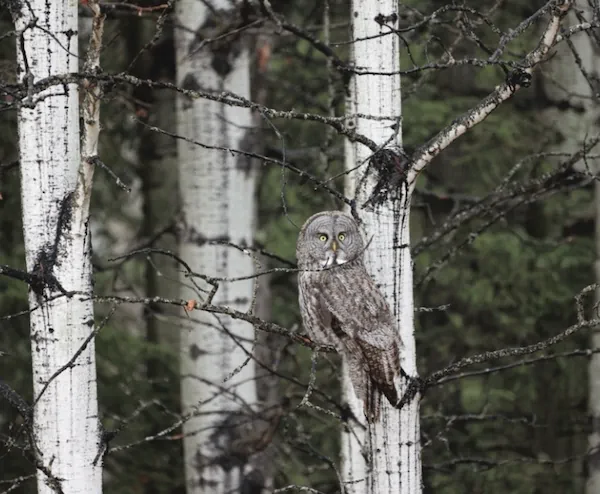All the leaves are down
And the sky is grey
I'll go for a walk
On a winter's day
I might see a ghost
If I am a birder
The great grey owl prowls
On such a winter's day.
Not the best version of a Mamas and Papas song, but one that will fill my head nonetheless as I meander through the foothills in November seeking the tallest, yet one of the most elusive owls in North America, the great grey owl. The Latin name Strix nebulosa roughly translates to screeching owl of a cloudy sky, describing its beautiful dappled grey plumage that camouflage it so well in our boreal and parkland forests. Many refer to it as a ghost, phantom, or spectre of the forest as they fly silently and blend in so magnificently. They are so good at hiding that Europeans discovered them in North America before realizing there was a Eurasian population as well. I prefer to search for these ghosts of the forest in the winter for a few reasons.
The first is because the snow and cold drive not only the leaves away making it easier to see them against the trees, but also other less hardy neighbours. Fairweather humans and songbirds are a noisy bunch so having the quiet of winter helps when listening for the repetitive hoo, hoo, hoos. They have a soft call; the screeching part of their name could refer to the juvenile calls and not the adults. If you are lucky enough to come across one of these owls admire their disc shaped face and distinctive white bowties, but do not approach too closely as they do not enjoy being disturbed. Despite their apparent formidable size, great grey owls are almost all fluffy feathers and weigh just over two lbs.
The feathers serve more than just keeping them warm and looking big. The feathers specialized design helps them silently fly through the air. The feathered disc of their face helps to collect sound to their asymmetrical ears, both in shape and position, where they can use these ears to pinpoint sounds both vertically and horizontally. This ability allows them to detect their small prey, like voles and mice from a great distant and silently swoop in for a meal. In the winter, even if you are not lucky enough to find a great grey you may come across one of my favourite tracks. A hole in the snow surrounded by the outstretched wing tips of an owl’s feathers. This is from a hunting technique referred to as snow-plunging, a favourite method of the great grey. They perch or hover listening for their prey beneath the snow, and when they locate one, plunge into the snow seemingly face first, but at the last moment switch to talons first. One study by Michael Collins recorded these plunges to a depth of 33cm! I guess if you’re an owl “who” needs to eat up to seven voles a night to stay warm, sometimes you have to take the plunge.
There is no “talon” what you might find on your next winter wander, but I hope it is a hoot.


























